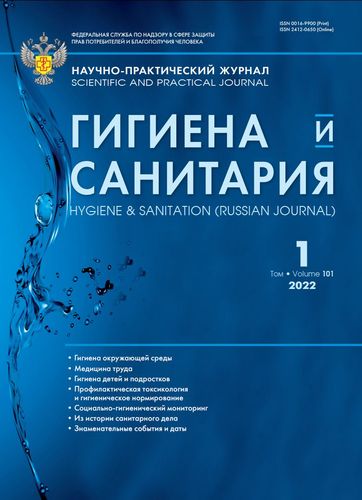Epidemic and sanitary charts and tables of the second half of the XIX century as the “health passports” for Russian territories
- Авторлар: Vishlenkova E.A.1, Zatravkin S.N.1,2
-
Мекемелер:
- National Research University “Higher School of Economics”
- National Research Institute of Public Health named after N.A. Semashko
- Шығарылым: Том 101, № 1 (2022)
- Беттер: 102-107
- Бөлім: FROM THE HISTORY OF SANITARY AFFAIRS
- ##submission.datePublished##: 10.02.2022
- URL: https://freezetech.ru/0016-9900/article/view/639563
- DOI: https://doi.org/10.47470/0016-9900-2022-101-1-102-107
- ID: 639563
Дәйексөз келтіру
Толық мәтін
Аннотация
The title of this article reproduces the intentions of the creators of the health cards and the hopes of their modern viewers. Judging by the statements, they wanted to see and show the state of the sanitary and epidemiological situation in the Russian Empire and wanted to do it as reliably and clearly as possible. The article’s authors asked themselves a question: have these desires and hopes come true, that is — are now the tables of sanitary statistics and disease maps “health passports” of various administrative and territorial units of the Russian Empire? Can historians use them as reliable evidence? In order to answer this question, it was necessary to reconstruct then existing system for recording and collecting data on infectious patients, diseases and pathogenicity, ways of their aggregation and representation. Only then would it be possible to find out how these data were applied to conditional terrain images, why either manufactured terrain plans or an administrative map of the empire were used, what was visible and what was in the dark zone.
The article’s authors found that the resources available in post-reform Russia did not make it possible to make the collection of sanitary statistics total for the entire territory timely, and even more so to organise a retest of practical information. The supply of information depended on the density of the network of medical institutions in the empire and doctors’ ideas about the value of such information. This circumstance ensured fragmented, multi-temporal and spatial asymmetry in showing the sanitary condition of the Russian Empire and the morbidity of its inhabitants. On this basis, medical historians are advised to read these mediums in the reverse perspective: high morbidity rates should be read as evidence of well-organised medical care (i.e. relative epidemic well-being) and vice versa.
Contribution. All co-authors made an equal contribution to the research and preparation of the article for publication.
Conflict of interest. The authors declare no conflict of interest.
Acknowledgement. The research was supported by the Russian Science Foundation (project no. 19-48-04110) and The German Research Foundation (DFG).
Received: November 30, 2020 / Accepted: November 25, 2021 / Published: February 09, 2022
Негізгі сөздер
Авторлар туралы
Elena Vishlenkova
National Research University “Higher School of Economics”
Хат алмасуға жауапты Автор.
Email: evishlenkova@hse.ru
ORCID iD: 0000-0002-9471-0091
MD, PhD, DSci, professor, the Chief Researcher of the Poletayev Institute for Theoretical and Historical Studies in the Humanities, National Research University “Higher School of Economics”, Moscow, 107000, Russian Federation.
e-mail: evishlenkova@hse.ru
РесейSergei Zatravkin
National Research University “Higher School of Economics”; National Research Institute of Public Health named after N.A. Semashko
Email: noemail@neicon.ru
ORCID iD: 0000-0002-2930-1873
Ресей
Әдебиет тізімі
- Markovin A.P. Development of Medical Geography in Russia [Razvitie meditsinskoy geografii v Rossii]. St. Petersburg: Nauka; 1993. (in Russian)
- Haeser H. Geschichte der epidemischen Krankheiten: Lehrbuch der Geschichte der Medizin und der epidemischen Krankheiten. Jena; 1865: 991. (in German)
- Vishlenkova E.A., Il‘ina K.A. The science of rulership: domination through knowledge and the administrative reform of Russian education in the first half of the nineteenth century. Ab Imperio. 2017; 2017(4): 65–107. https://doi.org/10.1353/imp.2017.0077 (in Russian)
- Rychkov S.Yu. Review of conventional signs in topographic survey and mapping of the area by Russian military topographers during the Napoleonic wars. In: The Patriotic war of 1812: Sources. Monuments. Problems [Otechestvennaya voyna 1812 goda: Istochniki. Pamyatniki. Problemy]. Borodino; 2017: 47–74. (in Russian)
- Vild G. Temperature conditions in the Russian Empire [O temperature vozdukha v Rossiyskoy imperii]. St. Petersburg; 1878–1882. (in Russian)
- Chuprov A.I. Statistics as a Link between Natural Science and Social Science [Statistika kak svyazuyushchee zveno mezhdu estestvoznaniem i obshchestvovedeniem]. Moscow; 1894. (in Russian)
- Snegirev V.S. Public Health in the Tula Region. Arkhiv sudebnoy meditsiny i obshchestvennoy gigieny. 1867; 1(3): 5. (in Russian)
- Rules for Medical and Statistical Registration in Zemstvo, Factory and other Medical Institutions of the Moscow Region. Nomenclature of Diseases [Pravila po mediko-statisticheskoy registratsii v zemskikh, fabrichnykh i drugikh meditsinskikh uchrezhdeniyakh Moskovskoy gubernii. Nomenklatura bolezney]. Moscow; 1886. (in Russian)
- Zhbankov D.N. Some results of the city medical and sanitary device. Obshchestvennyy vrach. 1915; (7–8): 449–85. (in Russian)
- Zhbankov D.N. Compendium on Urban Medical and Sanitary Affairs in Russia [Sbornik po gorodskomu vrachebno-sanitarnomu delu v Rossii]. Moscow; 1915. (in Russian)
- Zemstvo’s Medical Congresses in Tambov Region. Creation of Sanitary and Epidemiological Agencies [Zemskie vrachebnye s”ezdy v Tambovskoi gubernii. Sozdanie sanepidorganov]. Available at: https://68.rospotrebnadzor.ru/content/589/ (in Russian)
- Novoselskiy S.A. Subject and Content of National Sanitary Statistics in the pre-Soviet Period of its Development. In: Scientific Notes of Moscow State University of Economics, Statistics and Informatics. Volume 6. Proceedings of the Department of Demography [Uchenye zapiski MESI. Tom 6. Trudy kafedry demografii]. Moscow; 1955. (in Russian)
- Toropov N.I. Experience of Medical Geography of the Caucasus in the Treatment of Intermittent Fevers [Opyt meditsinskoy geografii Kavkaza otnositel’no peremezhayushchikhsya likhoradok]. St. Petersburg; 1864. (in Russian)
- Vishlenkova E.A., Renner A. Historical study of medical geography in Russia. Problemy sotsial’noy gigieny, zdravookhraneniya i istorii meditsiny. 2019; 27(5): 924–30. https://doi.org/10.32687/0869-866X-2019-27-5-924-929 (in Russian)
Қосымша файлдар







